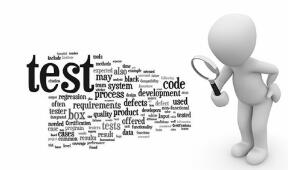Software testing is to detect software defects as early as possible to ensure defect repair to improve software quality. The key to determining software quality is demand analysis, design, and implementation. Testing is an inspection method that runs through the above process. Even if the functions are developed well and have not been tested, this is an unreliable program. This article mainly introduces the basic knowledge of software testing, and describes in detail the purpose, principles, objects, classification, testing process and precautions of software testing. Software testing is a process that describes the correctness, completeness, security, and quality of software used to facilitate identification. In other words, software testing is a process of review or comparison between actual output and expected output. The classic definition of software testing is the process of operating a program under specified conditions to discover program errors, measure software quality, and evaluate whether it can meet design requirements. Simply put, software testing is the process of executing a program to discover errors. Software testing is an important part of software quality assurance (QA). Testing is the execution of the program with the purpose of finding errors; A good test case is to find out what has not been found so far; A successful test was the discovery of a false test that has not been discovered so far; All software testing should be traced back to user needs The motto "Test software testing as early as possible and continuously" should be used as a tester's motto. Complete testing is impossible and testing needs to be terminated Tests cannot show potential defects in the software; Pay attention to the clustering phenomenon in testing Programmers should avoid checking their own programs Try to avoid the arbitrariness of the test Software testing runs through the entire software life cycle, and the objects and methods tested at different stages are different. It mainly includes executable research reports, project implementation plans, software requirements specifications, or system function specifications. Outline design specification, detailed design specification, and source program at the development stage. Software testing is mainly divided into white box and black box. The white box cares about the internal design and program implementation of the software. The basis is the design document. The black box does not care about the internal of the software and only cares about the input and output. The basis is the requirement document. The white box is generally the responsibility of the developer, testing the unit code, and what we generally think of as a software test engineer is a black box test that is responsible for the overall system flow test. The black box test also includes: Functional tests (according to requirements, verification functions), user interface effects (ease of use, visual effects), performance tests (speed of processing business), robustness tests (in case of anomalies, the system's fault tolerance and recovery capabilities), security Sex test, stress test (load of limit state), reliability test, installation/unload test Black box test method: Equivalence class divisions (sets of identical values, avoiding repetitive tasks), boundary value analysis, false guesses, causality maps, scene analysis. In fact, there is a gray box test, focusing on the interface of the program, focusing on the correctness of the output for the input, and determining the internal operating state by characterizing the conditions and conditions. Mainly used and integrated testing phase. 1, unit testing, that is, one function module for testing (white box testing) 2. Integration test, after the interface is integrated, test the accuracy of the interface transmission data (black box, white box test, also called gray box test) 3, system testing, networking, overall process testing (black box testing) 4, acceptance test, acceptance test by the customer (black box) 1. Develop a test plan to arrange personnel, project phases, time, test tools, browsers, etc., as required; 2, design test cases, according to the requirements specification, write clear test conditions, steps, results, that is how to measure; 3, the implementation of the test, when the test plan, the use case has been approved and the test object after the development can be started, found that the problem is submitted to the development of the bug, repair and then return to the test; 4. Write a test report, which includes what functions were tested in this stage, what were the problems, the severity of the problem, and alternative solutions to the problem that could not be repaired; 5. The passing rate of current functional test cases reaches 100%, and the passing rate of non-functional test cases reaches 90%. In the most recent time, there is no case of leaks and the test is completed. 1) There is legal data input, there is also illegal data input 2) Should perform regression testing after modifying the program 3) Full attention should be paid to the clustering phenomenon in the test (more problems are found, more problems are not found) 4) Proper retention of test plans, test cases, and related test reports 5) Make a thorough inspection of the test results to avoid omissions 6) Strictly implement the test plan and eliminate the randomness of the test Battery Anti-Theft System,Vibration Anti-Theft Function Battery,Gps Anti-Theft Function Battery,Monitoring On Computer And Phone Battery Wolong Electric Group Zhejiang Dengta Power Source Co.,Ltd , https://www.wldtbattery.com



March 27, 2023